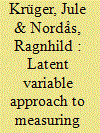| Srl | Item |
| 1 |
ID:
186337


|
|
|
|
|
| Summary/Abstract |
“Ending impunity” is often heralded as the key mechanism for stopping rape in war. Yet, little systematic evidence or analyses exist of the relationship between impunity (or lack thereof) and sexual violence. We argue that amnesties signal impunity and permissiveness for sexual violence, which can perpetuate and instigate more sexual violence by rebels. Trials, on the other hand, signal a nonzero probability of punishment, which could have a deterrent effect. Studying all intrastate armed conflicts in the period 1989–2011, we find in line with the impunity signal that amnesties are associated with sexual violence by rebels, but we are not able to demonstrate a deterrent effect of trials. While the study prevents us from conclusively saying that ending impunity would be an effective policy tool to stop sexual violence in war, the association between amnesties and subsequent sexual violence is a testament to the perils of impunity.
|
|
|
|
|
|
|
|
|
|
|
|
|
|
|
|
| 2 |
ID:
176042


|
|
|
|
|
| Summary/Abstract |
Conflict-related sexual violence is an international security problem and is sometimes used as a weapon of war. It is also a complex and hard-to-observe phenomenon, constituting perhaps one of the most hidden forms of wartime violence. Latent variable models (LVM) offer a promising avenue to account for differences in observed measures. Three annual human rights sources report on the sexual violence practices of armed conflict actors around the world since 1989 and were coded into ordinal indicators of conflict-year prevalence. Because information diverges significantly across these measures, we currently have a poor scientific understanding with regard to trends and patterns of the problem. In this article, we use an LVM approach to leverage information across multiple indicators of wartime sexual violence to estimate its true extent, to express uncertainty in the form of a credible interval, and to account for temporal trends in the underlying data. We argue that a dynamic LVM parametrization constitutes the best fit in this context. It outperforms a static latent variable model, as well as analysis of observed indicators. Based on our findings, we argue that an LVM approach currently constitutes the best practice for this line of inquiry and conclude with suggestions for future research.
|
|
|
|
|
|
|
|
|
|
|
|
|
|
|
|
| 3 |
ID:
165430


|
|
|
|
|
| Summary/Abstract |
While we know that war can have wide-ranging consequences for life expectancy, social capital, and political participation, we know little about how wartime violence affects intimate relationships. Existing literature suggests that conflict violence could increase the risk of intimate-partner violence, but lacks compelling statistical evidence to evaluate this claim. We test this proposition with newly available data on conflict-related violence and the Demographic and Health Surveys data on intimate-partner violence in Peru. We find that exposure to general conflict violence significantly increases the risk of intimate-partner abuse and that these effects are particularly pronounced for conflict-related sexual violence. This information should help policy makers and practitioners improve the efficacy of domestic violence prevention programs by identifying and targeting populations most at risk.
|
|
|
|
|
|
|
|
|
|
|
|
|
|
|
|